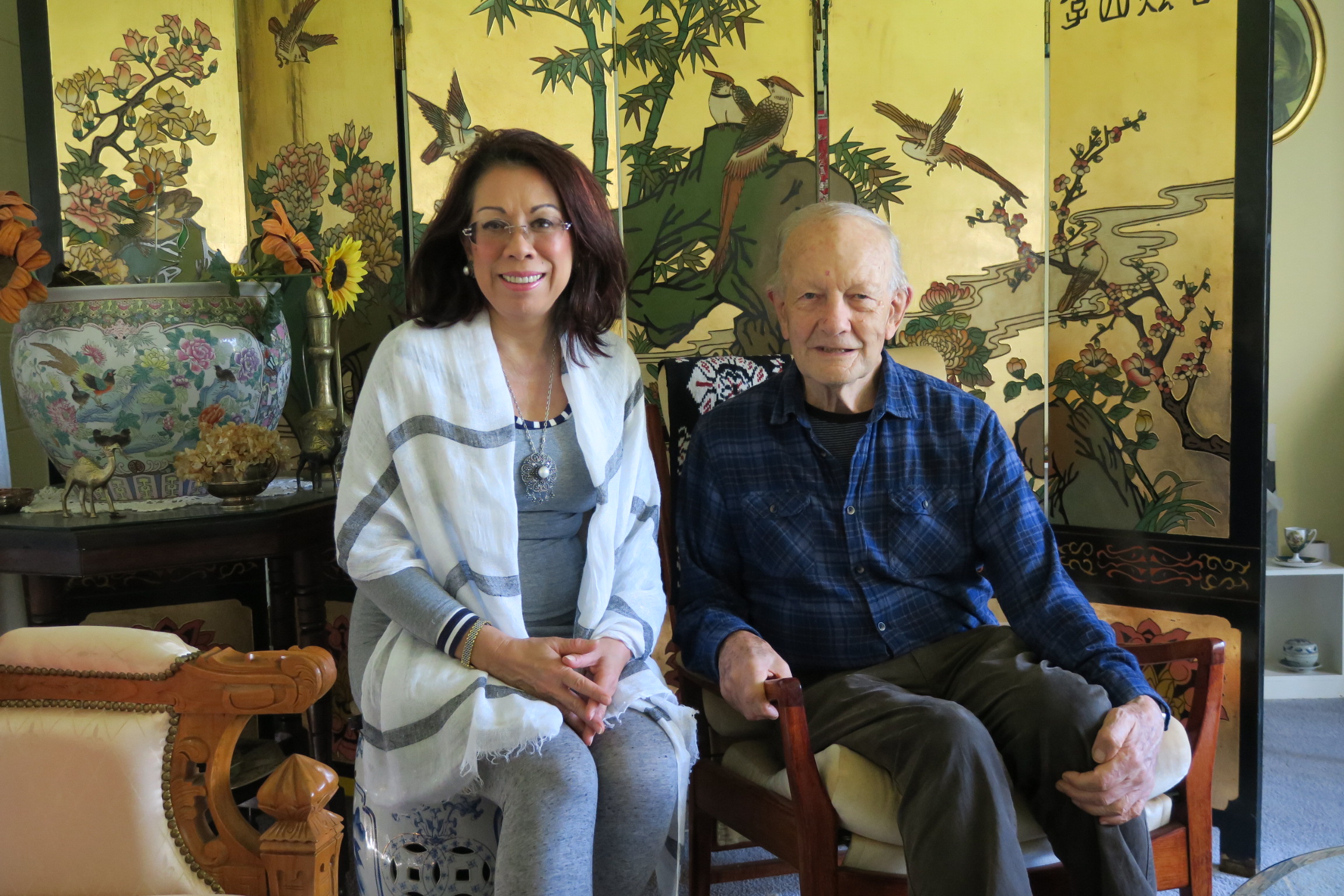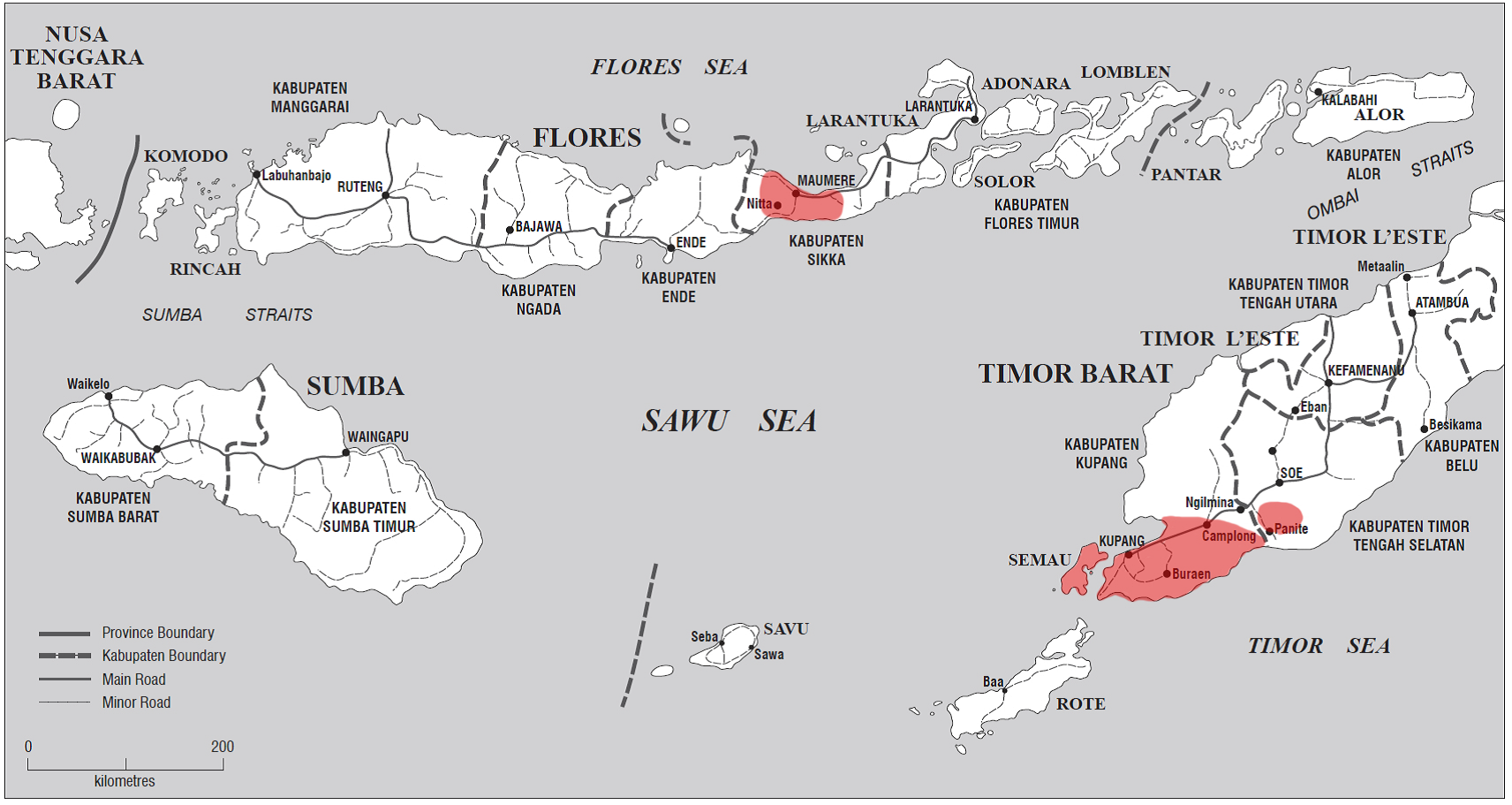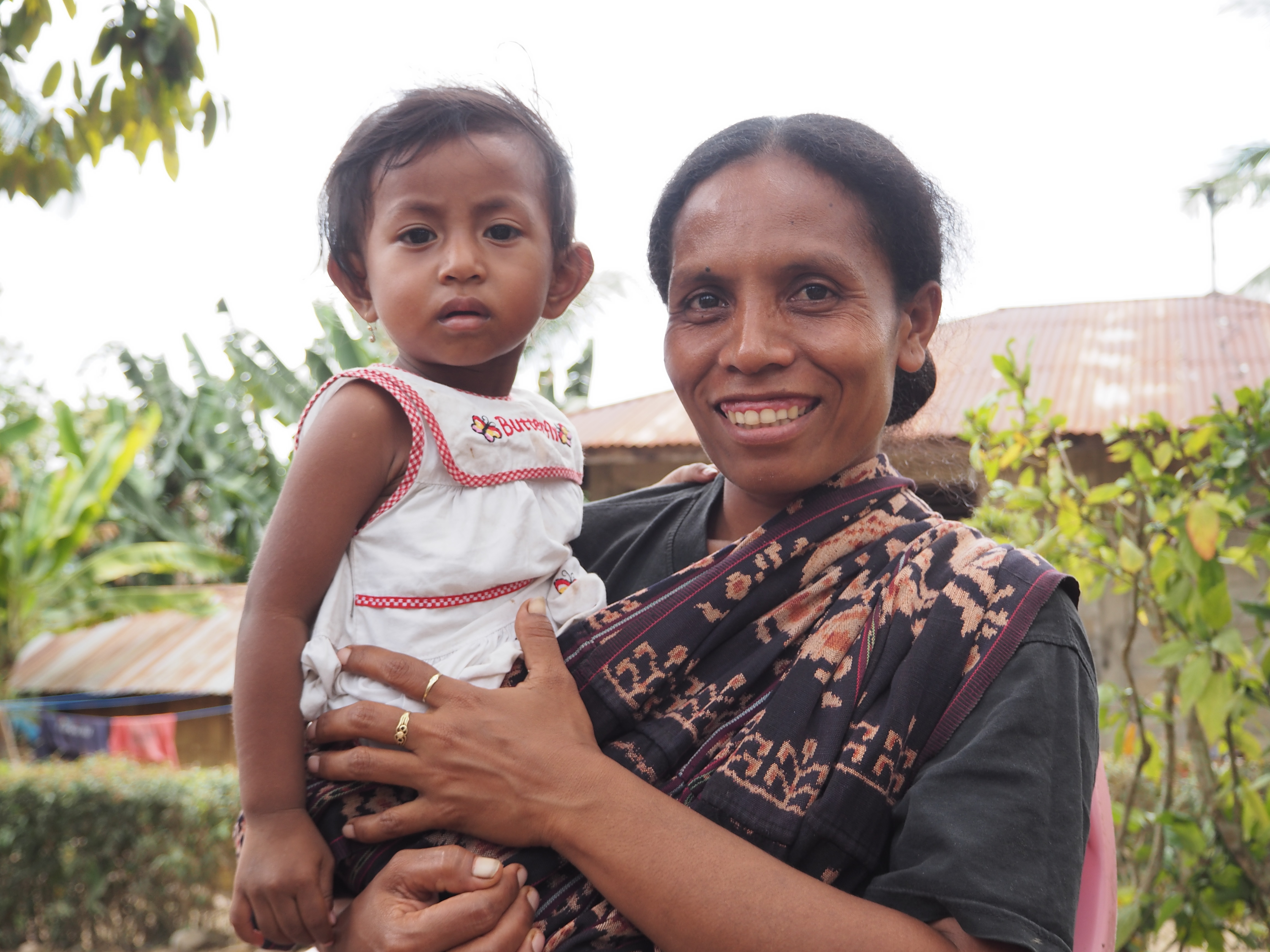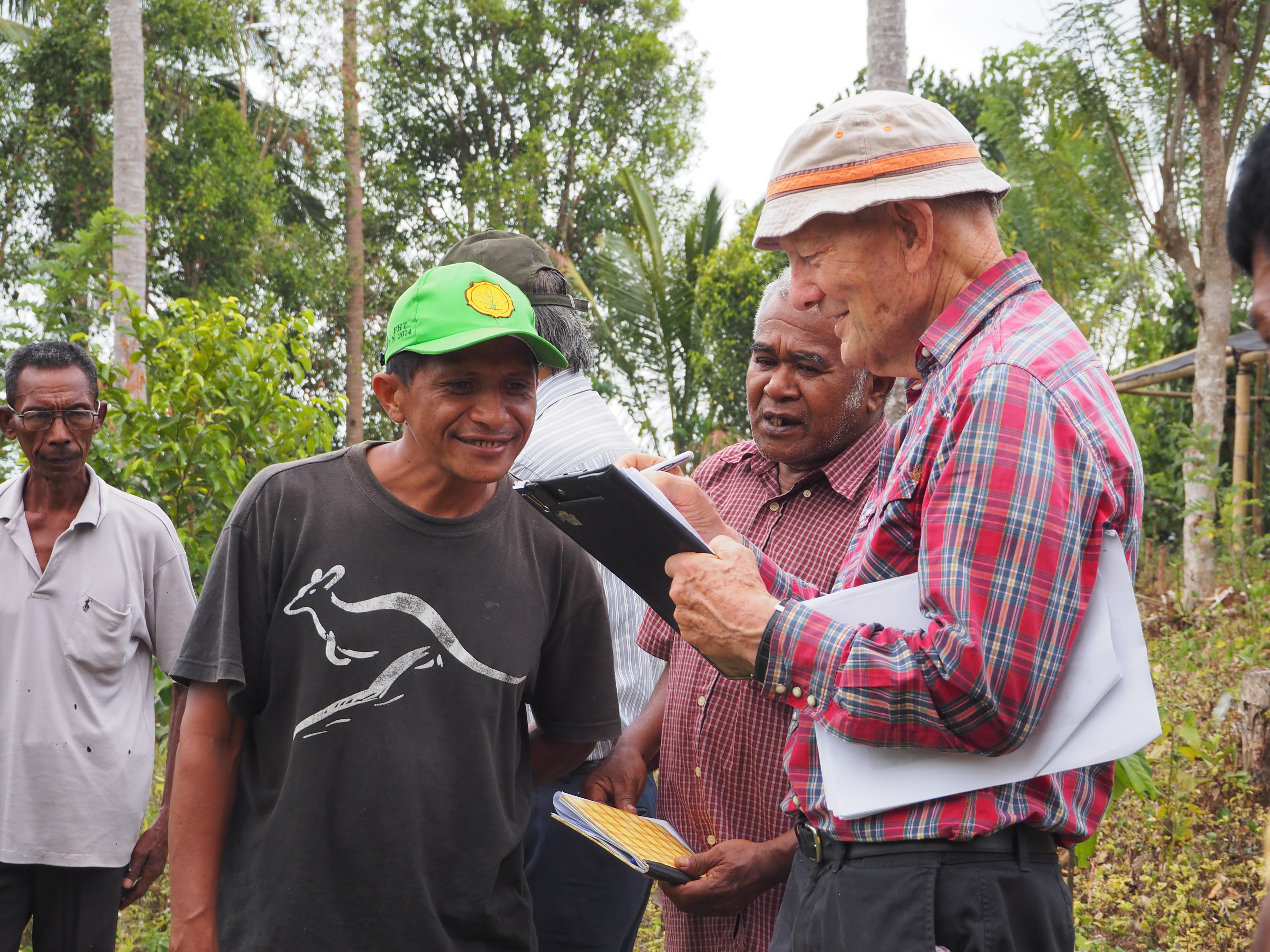Not the Millennium Villages: Colin and Ria in Eastern Indonesia

By Stephen Howes
When Colin Barlow and Ria Gondowarsito worked together on a report on poverty in Eastern Indonesia in the late 1980s, they didn’t know that it would lead to love, and become their life’s work. Over the subsequent thirty years, the Nusatenggara Association (commonly known as NTA East Indonesia Aid) has made a real difference to some of Indonesia’s poorest and most drought-prone communities. Colin and Ria’s story is both inspirational and educational.
The report that didn’t sit on the shelves
The 1988 report Development in Eastern Indonesia: the case of Nusa Tenggara Timur can still be found in library archives. Among its authors were Dr Colin Barlow, an agricultural economist then with The Australian National University (ANU), and Dr Ria Gondowarsito, an Indonesian sociologist then working at a university in Jakarta.
The Nusa Tenggara Timur (NTT) report was financed by Australia’s aid program. I’ve read it, and it’s good. If you like reports, as I do. But most reports date quickly, and sink without a trace – and I say that from personal experience.
This report was destined to be different. This report changed the lives of its authors, and thereby the lives of thousands of Indonesians.
In discussions with the relevant Indonesian officials, back in 1988, one challenged the authors: “Is this going to be another dusty report put on a shelf?” Colin and Ria decided to take up the challenge. And so began a journey that is still underway today.

Income, education and water
Nusa Tenggara – the Southeastern Islands – is an archipelago that stretches horizontally from Bali in the west to East Timor. The province of East Nusa Tenggara (Nusa Tenggara Timur, or NTT) has a population of 4.7 million, and consists of more than 500 islands. It is the part of Indonesia that is closest to Australia.
NTT has made significant progress over the last 30 years. When Colin and Ria first arrived, there were hardly any roads, and indeed hardly any cash. Most exchange was via barter. Today things are quite different. The islands are electrified, and motorbikes abound. But the islands of NTT are still very poor. If the province were a country, it would be one of the poorest in the world. Income per person is one third of the Indonesian average.
Colin describes the province as “one of the driest and poorest parts of Southeast Asia. Large parts of the province suffer from water shortages during the lengthy dry season.” Cash crops are on the rise, but most of NTT’s inhabitants are still subsistence farmers. A recent survey found that almost 40% of the population is malnourished.
In 1988 – the year of the report – Colin and a friend, Shirley Bowman, founded what is now the Nusatenggara Association (commonly known as NTA East Indonesia Aid), an Australian-registered non-governmental organisation (NGO). Shirley moved to Melbourne and to onerous business responsibilities shortly thereafter, but both Colin and Ria became increasingly involved with NTA. Over the years, it has come to take up to about two thirds of their time, provided entirely on a voluntary basis. Colin is NTA’s CEO, and Ria its Program Manager.
NTA works on NTT’s largest island, Flores, and in West Timor, the part of the island of Timor that remains with Indonesia. The map below shows the areas (selected partly through contacts, and partly because these are the poorest parts of NTT) in which NTA works. Although they constitute only a small part of the province, these project areas are home to almost half of NTT’s population. NTA estimates that at any one time it is working with about 10,000 individuals.

NTA has its own team on the ground, with a staff of about 15. It also funds and works closely with two local NGOs, and collaborates with various government agencies.
NTA works on three main types of projects.
First, it provides water tanks and toilets for households. Or rather, NTA donates the materials. Households have to provide the labour. About 1,000 water tanks have been built in this way and nearly all are still working. These are large water tanks, made of cement, and with a capacity of 15,000 litres, filled from rooftops during the wet season. In regions where, especially in the dry season, collecting water can consume several hours, acquiring a tank is a transformational event. The water from the tanks is also used to flush the toilets, and having working household toilets is a big step forward for health outcomes. The tank water is also used for agriculture.
NTA also works with primary and secondary schools. It provides books and basic school infrastructure – from tables and chairs to toilets –runs in-service training, and provides scholarships to the poorest students. Recently, NTA has started supporting kindergartens. In all, NTA has helped some 120 schools and 14,500 students over the years. These interventions are harder to assess, but NTA’s intensive monitoring (discussed below) gives grounds for confidence. For many in NTT, the future lies in out-migration. A good education is critical for prospective migrants.
While NTA has worked hard to improve water and sanitation and education, it gives pride of place to its income-generating projects. These are the riskiest projects but also the most important. They are prioritised because, in the words of Colin:
“[It] is really the only way out of poverty. Of course we’re going to improve their conditions with water and sanitation and also by education. But in order to really get a substantial increase in income, we have to do more than that.”
These livelihood projects work through small groups of farmers—some 190 local cooperatives of 10-15 households each – which are provided with expert advice, new and improved inputs, and rotating funds to pay for them. The main focus is on the introduction of new cocoa and vegetable crops, maize, cattle, and small animals.
I asked Colin to nominate NTA’s most successful project.
“Seaweed. At the beginning, it was quite difficult. We tried to grow seaweed on rafts. It was all eaten by turtles. But over time, we managed to adjust to that, and now we have it on long lines. This took a long time to develop, probably about 15 years. At the beginning, we had several hundred farmers involved with this, then everyone dropped out when the project failed. But now there are 3,000 or 4,000 farmers growing seaweed, and it’s a major source of income.”
Colin estimates that seaweed provides additional net income of some $750 per participating farmer, although this varies with price and yield fluctuations.
I also asked for an example of a failure. Ria mentioned pigs; Danish-style pigs.
“We introduced Danish pigs on Flores because the Danish pigs can give more than 12 piglets. But we didn’t consider that there was just not enough water. People needed water, and if they had any pigs, they’re competing with water. The pigs needed a bath, needed to drink. They also got quite serious sunburns. They were a complete failure.”
Amid success and failure, NTA continues with its livelihood projects. Colin and Ria are encouraged by the improvement in repayment rates in the microfinance that they provide (now close to 90%), and proud of their collaboration with Indonesia’s Research Centre for Agricultural Technology, which provides its technical experts as trainers and supervisors. There is no shortage of problems (even their flagship seaweed project is periodically threatened by a fungus infestation). But overall, Colin says, NTA’s efforts have resulted in “higher and sustainable crop yields and better incomes being secured by growing numbers of rural households.”
Janet Hunt is an experienced development practitioner and academic. She recently joined the NTA Board and visited two of their project sites earlier this year. She told me that the tanks are “working really, really well” and that the agricultural projects “are clearly generating higher incomes for people.” She’d like to see NTA pay more attention to gender issues, but says that “it’s a really good agricultural extension project.” The farmers Janet talked to, women and men, talked about having better houses and better nutrition as a result of NTA’s interventions.
For the cost of a consultant
A number of evaluations and expert reviews have been undertaken of NTA’s work. It is hard to put a number on total benefits, but the seaweed project alone delivers annual returns to farmers well in excess of a million dollars a year. Then there are all the other agricultural projects, and the help with schooling. What value does one put on the provision of potable water? Last year, NTA provided 130 NTT households with water tanks, and 88 with toilets; funded 280 student scholarships, trained 200 teachers and supported some 50 schools; and provided almost 3,000 farmers with new livelihood opportunities.
NTA’s annual costs are an order of magnitude lower. NTA’s 2015 expenditure was financed by income of $366,900. $150,000 of this came from the Australian aid program: the smallest amount of funding an NGO is entitled to under the Australian government’s NGO support program. About $95,000 came from fundraising. The rest was the imputed value of labour provided by Colin, Ria and other colleagues. The total amount would not pay for a single in-country consultant employed by the Australian aid program for a year. That is value for money.

A fine balance
As important as what it does is how NTA goes about its development work. A small and humble outfit, NTA doesn’t have a statement of principles or values. If it did, I reckon it might highlight four things as particularly important.
The first is consultation. When I ask Ria and Colin what they have learnt from their decades of involvement, Colin says “The value of interaction. Interaction through community meetings and talking to all these different individuals.” Ria talks about “being adaptive to the local conditions.” On their regular trips to NTT the two, along with other Australian volunteers, participate in musyawarah, large community meetings that might go on for a whole day, discussing community priorities and problems. The projects they support follow directly from these meetings. Janet Hunt tells me that Colin is highly respectful of community members and “puts a lot of effort into relationships.”
The second is expertise and learning. NTA source a large number of experts in Australia, as volunteers. They might be engineers, or agriculturalists, or accountants. NTA also collaborates closely with Indonesian professional organisations, as illustrated by the agricultural example given earlier.
The third principle NTA seems to value is self-help. Ria says that from her training she knew “that handouts would not be the answer” and that right from the start the aim was empowerment. Counterpart contributions are always required; loans are preferred to grants; the role of model farmers is emphasised.
Close monitoring is the final tenet which NTA holds dear. Twice a year, Colin and Ria lead a supervision mission to NTT. They might visit for up to a month, heading out on separate trips for much of the time. The various teams review all aspects of NTA’s work, with a special focus on accounting. Corruption is an ever-present threat. The pair are frank in admitting that even loyal and long-serving staff may be tempted to misappropriate funds and they scrutinise expenditures closely to avoid this. Ria says:
“I think we have almost 100 percent success now. For many, many years we haven’t lost money at all. It’s only by dint of being extremely careful.”
What I like about these four principles is the tension between them. Consultation is balanced against expertise. Self-help against supervision. It is almost dialectic.
One pair of these principles adds up to a belief in informed outsiders. Outsiders are important because they “can have new insights which help,” as Colin puts it. But new ideas will be effective only when they are informed by local realities. “In order to implement these things successfully, you have to spend quite a bit of time there,” Ria muses.
The other pair of principles adds up a version of “trust but verify”. Work with local communities, not for them, but scrutinise what they do.
It all sounds convincing to me, and it seems to work. If it does, it is because of a fifth, underlying principle: that of taking a long-term perspective. NTA’s work is mercifully, indeed critically, not bound to the short life cycles that undermine so many government and indeed many NGO projects. They have the luxury of measuring time in decades rather than years.
Why is this important?
“It does need persistence. 25 years is nothing,” says Ria.
Colin adds: “We’re all working together on a similar problem. We’re all making serious mistakes. We’re learning.” The passing of time is also needed to develop good relations with the community:
“The fact that NTA has cooperated with local communities for decades means that it is far beyond an initial phase of polite and misleading responses.”
Finally, and paradoxically perhaps, such a long period is needed to ensure sustainability. “You can’t expect the community to be self-reliant, self-propelling,” cautions Ria.

Lessons for Paul Collier and Jeffrey Sachs
While the NTA footprint is small, even on the NTT scale, let alone on Indonesian or global ones, it is nevertheless full of interesting lessons for development practitioners and economists.
I can’t help contrast Ria and Colin’s careful, well-researched approach to that of Tara Winkler, and many other, enthusiastic young Australian volunteers who have set up overseas development projects on the basis of no more than a holiday abroad. In Tara’s case she set up an orphanage in Cambodia. She learnt the hard way that development without expertise is dangerous: in her case, that the more orphanages there were, the more poor Cambodian families would turn their kids over to them.

To her credit, Tara has come to regret her actions, as told through her recent book How (not) to start an orphanage – by someone who did. As a development practitioner myself, I can recall several times when I felt I was treading on very thin ice in the work I was engaged in, not really sure what was actually going on. We can all learn from Colin and Ria’s commitment to familiarity.
Academics as well as practitioners can learn from the pair’s experience. Listening to them, I was reminded of economist Paul Collier’s scepticism concerning small-holder agriculture. In one of his best-sellers, The Plundered Planet, Collier seeks to slay “the middle-class love affair with peasant agriculture.” He argues that the only reliable route out of poverty is off the farm. Factory jobs pay much better. Food should be grown by more efficient large companies, not by smallholders. Collier’s arguments are compelling, but what he neglects is that for the foreseeable future there will, come what may, be millions of poor smallholders, especially in remote regions. NTT will never be an industrial nor an agribusiness hub. Even large-scale tourism is an unlikely prospect. Many residents will leave NTT, but many will stay behind, and remain reliant on agriculture for decades to come. What else can they do? Working with these farmers to improve yields and to diversify is, for them, the route out of poverty.
But most of all, Colin and Ria’s story brought to my mind Jeffrey Sachs’ ill-fated Millennium Villages. For those unaware, prominent economist, UN adviser and Bono-collaborator Jeffrey Sachs set out to prove that aid could lift people out of poverty, provided a comprehensive enough approach was taken. Starting in 2004, he selected a number of African villages, and persuaded various donors to finance development projects in these villages in the areas of health, education, agriculture and infrastructure. The results have been underwhelming, as Nina Munk so tellingly revealed in her book The Idealist. There may have been some important progress in health (the formal evaluation is still to come), but much went wrong, and the villages, and the villagers within them, are still poor. Sachs himself seems to have lost interest. The funding appears to have run out. The project’s website has its most recent press release dated September 2014.
NTA’s work showed me why the Millennium Villages approach failed. Not enough research was done before the intervention, not enough time was taken for it, and expectations were too high. However transformative some of the NTA’s efforts, most of the households they help are still poor.

The biggest challenge
At a policy level, the NTA story has many lessons to teach us. But there is also a very personal and profoundly moving dimension to this story. Colin and Ria have gone from being co-authors to colleagues to husband and wife. NTA has become their joint life’s work. Their commitment is obvious, and, even now, fresh. As Colin has written in one of the recent NTA annual reports:
Those of us working in rural areas of Nusa Tenggara Timur cannot but be taken aback by the dire poverty, and by the stark contrast between the difficult lives of people there and the plush existences of people in Canberra. This is not something one ceases to notice, and it impresses itself on one again and again.
But Colin is now 84, Ria 62. Whether the organisation will survive the inevitable exit of its founders is an unanswered question. They have announced both in Australia and in Indonesia their intention to retire in 2018. Transition planning is now underway. Clearly leaving will not be easy, for either side. I hope that Colin and Ria’s work lives on. Their legacy certainly will.




